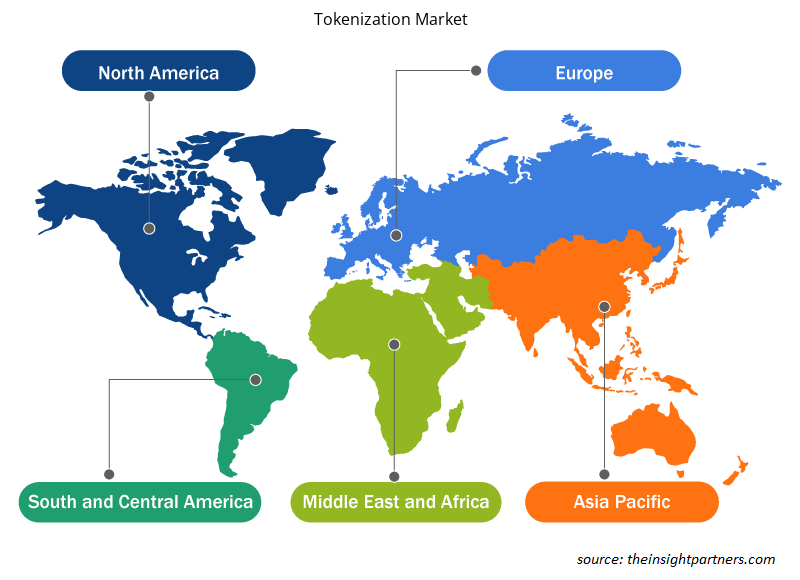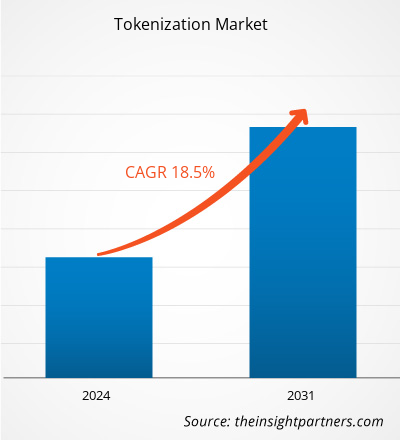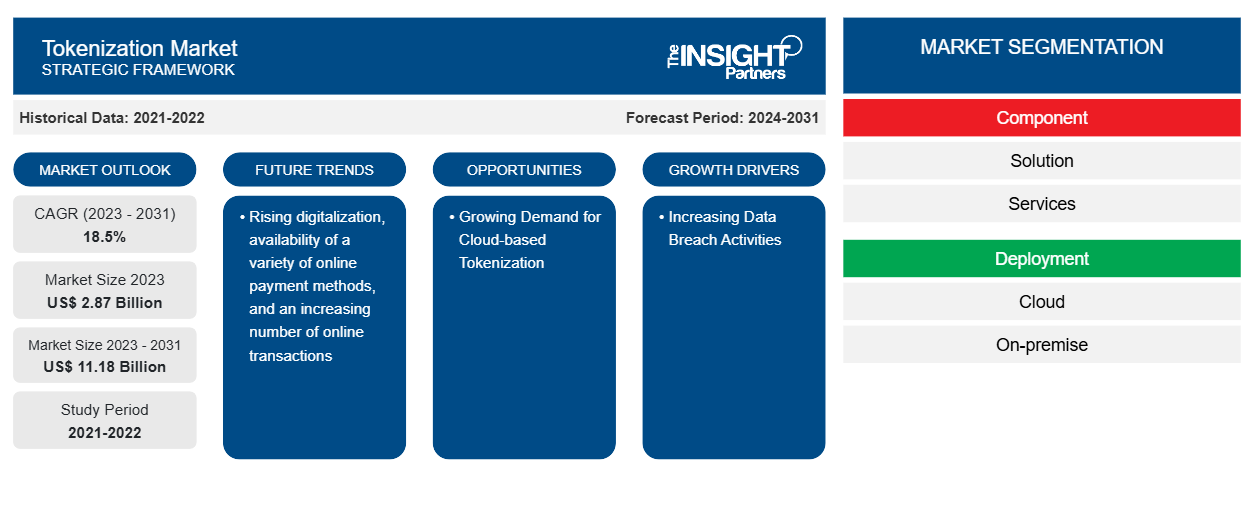Si prevede che la dimensione del mercato della tokenizzazione raggiungerà 11,18 miliardi di dollari entro il 2031, rispetto ai 2,87 miliardi di dollari del 2023. Si prevede che il mercato registrerà un CAGR del 18,5% nel 2023-2031. La crescente digitalizzazione, la disponibilità di una varietà di metodi di pagamento online e un numero crescente di transazioni online rimarranno probabilmente una tendenza chiave del mercato della tokenizzazione.
Analisi del mercato della tokenizzazione
Il mercato della tokenizzazione sta crescendo a un ritmo rapido a causa delle crescenti attività di violazione dei dati e delle crescenti preoccupazioni sulla sicurezza dei dati tra i consumatori in tutto il mondo. Il mercato si sta espandendo costantemente, spinto dalla domanda dei consumatori per i pagamenti contactless. Inoltre, la crescente domanda di tokenizzazione basata su cloud e le iniziative governative per le transazioni senza contanti stanno offrendo opportunità redditizie per la crescita del mercato della tokenizzazione.
Panoramica del mercato della tokenizzazione
La tokenizzazione è il processo di scambio o conversione di dati sensibili per dati non sensibili in parti più piccole chiamate "token". Può essere utilizzato in un database o in un sistema interno senza includerlo nell'ambito. I token non hanno quasi alcun valore intrinseco; sono utili solo quando rappresentano qualcosa di importante, come un numero di conto primario (PAN) di una carta di credito o un numero di previdenza sociale (SSN). La maggior parte delle organizzazioni archivia dati sensibili nei propri sistemi, che si tratti di informazioni sulla carta di credito, informazioni mediche, numeri di previdenza sociale o qualsiasi altra cosa che debba essere protetta e sicura. La tokenizzazione consente alle aziende di continuare a utilizzare questi dati per scopi commerciali senza il rischio o le implicazioni di conformità derivanti dalla conservazione interna di dati sensibili.
Personalizza questo report in base alle tue esigenze
Riceverai la personalizzazione gratuita di qualsiasi report, comprese parti di questo report, o analisi a livello nazionale, pacchetto dati Excel, oltre a usufruire di grandi offerte e sconti per start-up e università
-
Scopri le principali tendenze di mercato in questo rapporto.Questo campione GRATUITO includerà analisi di dati che spaziano dalle tendenze di mercato alle stime e alle previsioni.
Driver e opportunità del mercato della tokenizzazione
L'aumento delle attività di violazione dei dati sta guidando il mercato
I criminali prendono di mira le aziende che accettano carte di debito e carte di credito. Il pagamento effettuato con queste carte contiene informazioni preziose che possono essere rubate. Ciò aumenta l'adozione della tokenizzazione tra le aziende per proteggere informazioni preziose. La tokenizzazione aiuta le aziende a proteggersi da qualsiasi conseguenza finanziaria negativa del furto di dati. La tokenizzazione non solo protegge le informazioni finanziarie, ma aiuta anche le aziende a proteggere i propri dati personali dalle violazioni. Inoltre, la crescente adozione della tokenizzazione delle carte di credito tra le aziende per migliorare la sicurezza dei dati per le attività online sta guidando il mercato. La tokenizzazione fornisce sicurezza dei dati dal momento in cui i dati vengono acquisiti fino all'archiviazione eliminando l'archiviazione effettiva dei numeri delle carte di credito nei POS e nei sistemi interni.tokenization among businesses to protect valuable information. Tokenization helps businesses to protect themselves from any negative financial consequences of data theft. Tokenization not only protects financial information but also supports businesses to protect their personal data from breaches. Moreover, the growing adoption of tokenization among businesses to improve data security for online businesses is driving the market. Tokenization provides data security from the time data is being captured to storage by eliminating the actual storing of credit card numbers in POS machines and internal systems.
Crescente domanda di tokenizzazione basata su cloud: un'opportunità nel mercato della tokenizzazioneTokenization – An Opportunity in the Tokenization Market
La tokenizzazione basata su cloud è il processo di scambio di dati sensibili per un segnaposto irreversibile e non sensibile noto come token, mantenendo in modo sicuro i dati originali sensibili al di fuori dei sistemi interni dell'azienda. La tokenizzazione basata su cloud è più facile da implementare e meno costosa della tradizionale tokenizzazione on-premise. Ciò aiuta le aziende a ridurre il rischio e l'esposizione alla conformità rimuovendo i dati sensibili dai loro ambienti dati. Le aziende possono anche salvaguardare tali dati mantenendo l'utilità e l'agilità dei loro attuali processi aziendali utilizzando token che preservano il formato e la lunghezza come segnaposto per i dati originali sensibili. Ciò sta creando in modo significativo opportunità nel mercato durante il periodo di previsione.tokenization is the process of exchanging sensitive data for an irreversible, non-sensitive placeholder known as a token while securely maintaining the original, sensitive data outside of the business's internal systems. Cloud-based tokenization is easier to implement and less expensive than traditional on-premise tokenization. This helps businesses in lowering risk and compliance exposure by removing sensitive data from their data environments. Businesses can also safeguard that data while maintaining utility and the agility of their current business processes by utilizing format- and length-preserving tokens as a placeholder for the original, sensitive data. This is significantly creating opportunities in the market during the forecast period.
Analisi della segmentazione del rapporto di mercato sulla tokenizzazione Market Report Segmentation Analysis
I segmenti chiave che hanno contribuito alla derivazione dell'analisi di mercato della tokenizzazione sono i componenti, l'implementazione, le dimensioni aziendali e il settore verticale.
- In base al componente, il mercato della tokenizzazione è diviso in soluzioni e servizi. Il segmento delle soluzioni ha detenuto una quota di mercato maggiore nel 2023.
- In termini di distribuzione, il mercato è categorizzato come cloud e on-premise. Il segmento cloud ha detenuto una quota di mercato maggiore nel 2023.
- Sulla base delle dimensioni aziendali, il mercato della tokenizzazione è suddiviso in PMI e grandi imprese. Il segmento PMI ha detenuto una quota di mercato maggiore nel 2023.
- In termini di settore verticale, il mercato della tokenizzazione è segmentato in BFSI, Retail, IT e telecomunicazioni, sanità, governo e altri. Il segmento BFSI ha detenuto una quota di mercato maggiore nel 2023.
Analisi della quota di mercato della tokenizzazione per area geografica
L'ambito geografico del rapporto sul mercato della tokenizzazione è suddiviso principalmente in cinque regioni: Nord America, Asia Pacifico, Europa, Medio Oriente e Africa e Sud America/Sud e Centro America.
In termini di fatturato, il Nord America ha rappresentato la quota di mercato più grande della tokenizzazione, a causa della rapida adozione di nuove tecnologie innovative e della crescente domanda di soluzioni basate su cloud tra le aziende. Il crescente utilizzo di metodi di pagamento online e la crescita dell'acquisto ora, pagamento dopo con le criptovalute stanno alimentando il mercato. Molte società finanziarie negli Stati Uniti, come Visa e Mastercard, stanno fornendo servizi di transazione online e soluzioni di pagamento ai clienti in tutto il mondo. Ciò aumenta la domanda di tokenizzazione per la protezione dei dati. Ad esempio, nell'agosto 2022, Visa ha emesso oltre 4 miliardi di token di rete a livello globale tramite Visa Token Service (VTS) per supportare i token digitali.
Approfondimenti regionali sul mercato della tokenizzazione
Le tendenze regionali e i fattori che influenzano il mercato della tokenizzazione durante il periodo di previsione sono stati ampiamente spiegati dagli analisti di Insight Partners. Questa sezione discute anche i segmenti e la geografia del mercato della tokenizzazione in Nord America, Europa, Asia Pacifico, Medio Oriente e Africa e America meridionale e centrale.

- Ottieni i dati specifici regionali per il mercato della tokenizzazione
Ambito del rapporto sul mercato della tokenizzazione
| Attributo del report | Dettagli |
|---|---|
| Dimensioni del mercato nel 2023 | 2,87 miliardi di dollari USA |
| Dimensioni del mercato entro il 2031 | 11,18 miliardi di dollari USA |
| CAGR globale (2023-2031) | 18,5% |
| Dati storici | 2021-2022 |
| Periodo di previsione | 2024-2031 |
| Segmenti coperti |
Per componente
|
| Regioni e Paesi coperti |
America del Nord
|
| Leader di mercato e profili aziendali chiave |
|
Densità degli attori del mercato della tokenizzazione: comprendere il suo impatto sulle dinamiche aziendali
Il mercato del Tokenization Market sta crescendo rapidamente, spinto dalla crescente domanda degli utenti finali dovuta a fattori quali l'evoluzione delle preferenze dei consumatori, i progressi tecnologici e una maggiore consapevolezza dei vantaggi del prodotto. Con l'aumento della domanda, le aziende stanno ampliando le loro offerte, innovando per soddisfare le esigenze dei consumatori e capitalizzando sulle tendenze emergenti, il che alimenta ulteriormente la crescita del mercato.
La densità degli operatori di mercato si riferisce alla distribuzione di aziende o società che operano in un particolare mercato o settore. Indica quanti concorrenti (operatori di mercato) sono presenti in un dato spazio di mercato in relazione alle sue dimensioni o al valore di mercato totale.
Le principali aziende che operano nel mercato della tokenizzazione sono:
- Broadcom, Inc
- FUTUROEX
- Fiserv, Inc.
- Micro Focus International plc
- Società OpenText
- Sequent Software Inc
Disclaimer : le aziende elencate sopra non sono classificate secondo un ordine particolare.

- Ottieni una panoramica dei principali attori del mercato della tokenizzazione
Notizie e sviluppi recenti sul mercato della tokenizzazione
Il mercato della tokenizzazione viene valutato raccogliendo dati qualitativi e quantitativi dopo la ricerca primaria e secondaria, che includono importanti pubblicazioni aziendali, dati associativi e database. Di seguito è riportato un elenco di sviluppi nel mercato della tokenizzazione e delle strategie:
- Gennaio 2024: il BIS Innovation Hub annuncia i primi sei progetti per il programma di lavoro del 2024, tra cui i prossimi progetti incentrati su sicurezza e protezione, finanza verde e infrastrutture finanziarie di nuova generazione; sono inoltre previsti ulteriori lavori su analisi avanzate dei dati e tokenizzazione. (Fonte: BIS, comunicato stampa, 2024)
Copertura e risultati del rapporto sul mercato della tokenizzazione
Il rapporto “Dimensioni e previsioni del mercato della tokenizzazione (2021-2031)” fornisce un’analisi dettagliata del mercato che copre le seguenti aree:
- Dimensioni e previsioni del mercato a livello globale, regionale e nazionale per tutti i segmenti di mercato chiave coperti dall'ambito
- Dinamiche di mercato come fattori trainanti, vincoli e opportunità chiave
- Principali tendenze future
- Analisi dettagliata delle cinque forze PEST/Porter e SWOT
- Analisi di mercato globale e regionale che copre le principali tendenze di mercato, i principali attori, le normative e gli sviluppi recenti del mercato
- Analisi del panorama industriale e della concorrenza che copre la concentrazione del mercato, l'analisi della mappa di calore, i principali attori e gli sviluppi recenti
- Profili aziendali dettagliati
- Analisi storica (2 anni), anno base, previsione (7 anni) con CAGR
- Analisi PEST e SWOT
- Valore/volume delle dimensioni del mercato - Globale, Regionale, Nazionale
- Industria e panorama competitivo
- Set di dati Excel
Report recenti
Testimonianze
Motivo dell'acquisto
- Processo decisionale informato
- Comprensione delle dinamiche di mercato
- Analisi competitiva
- Analisi dei clienti
- Previsioni di mercato
- Mitigazione del rischio
- Pianificazione strategica
- Giustificazione degli investimenti
- Identificazione dei mercati emergenti
- Miglioramento delle strategie di marketing
- Aumento dell'efficienza operativa
- Allineamento alle tendenze normative























 Ottieni un campione gratuito per - Mercato della tokenizzazione
Ottieni un campione gratuito per - Mercato della tokenizzazione